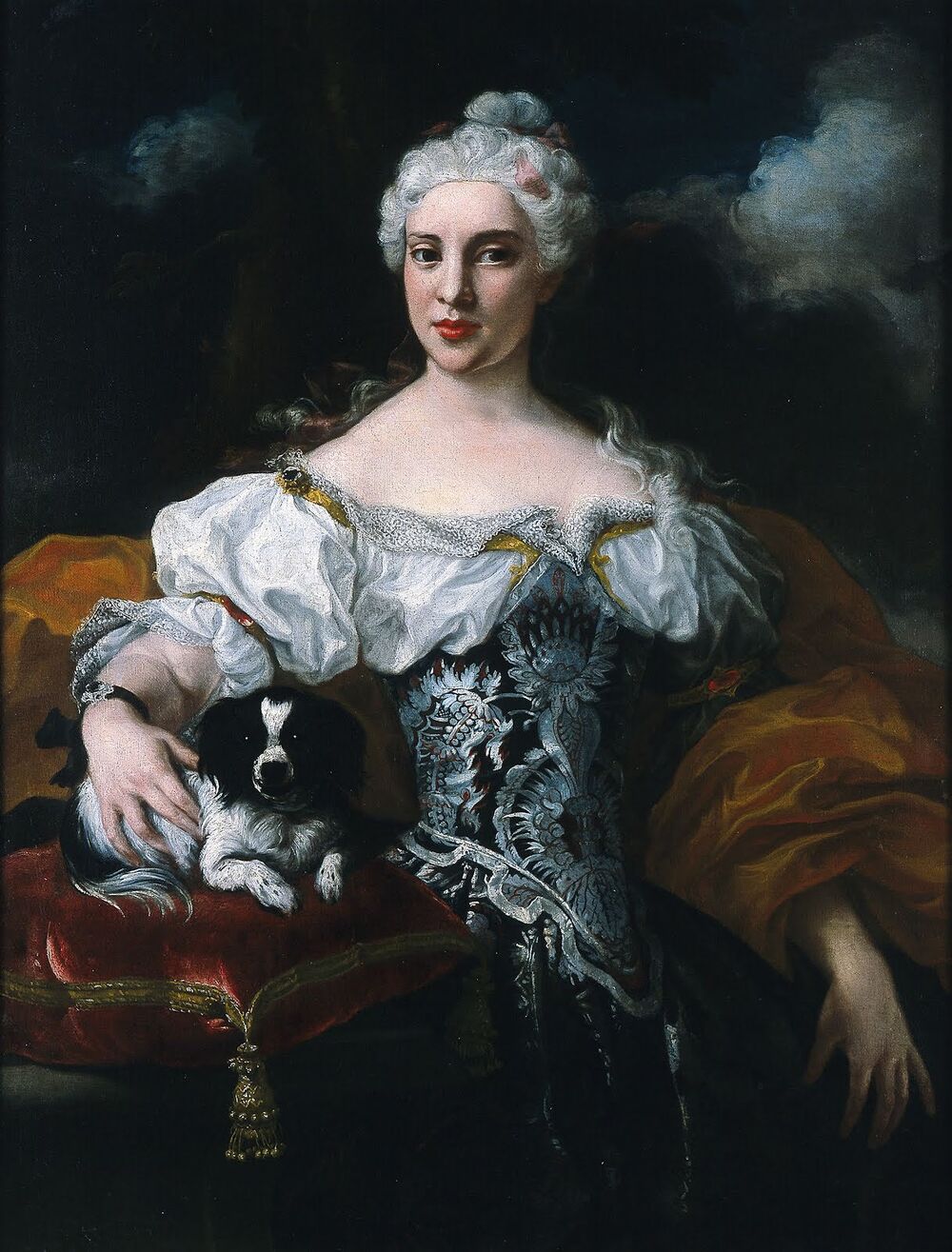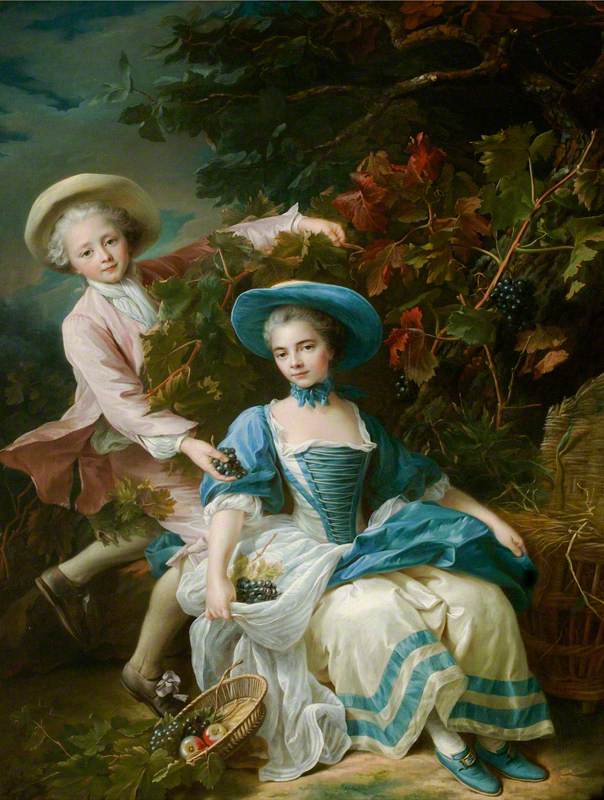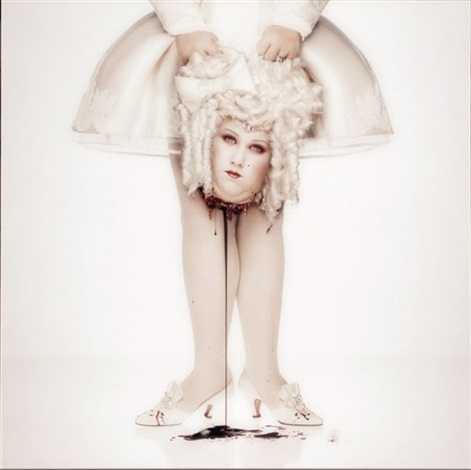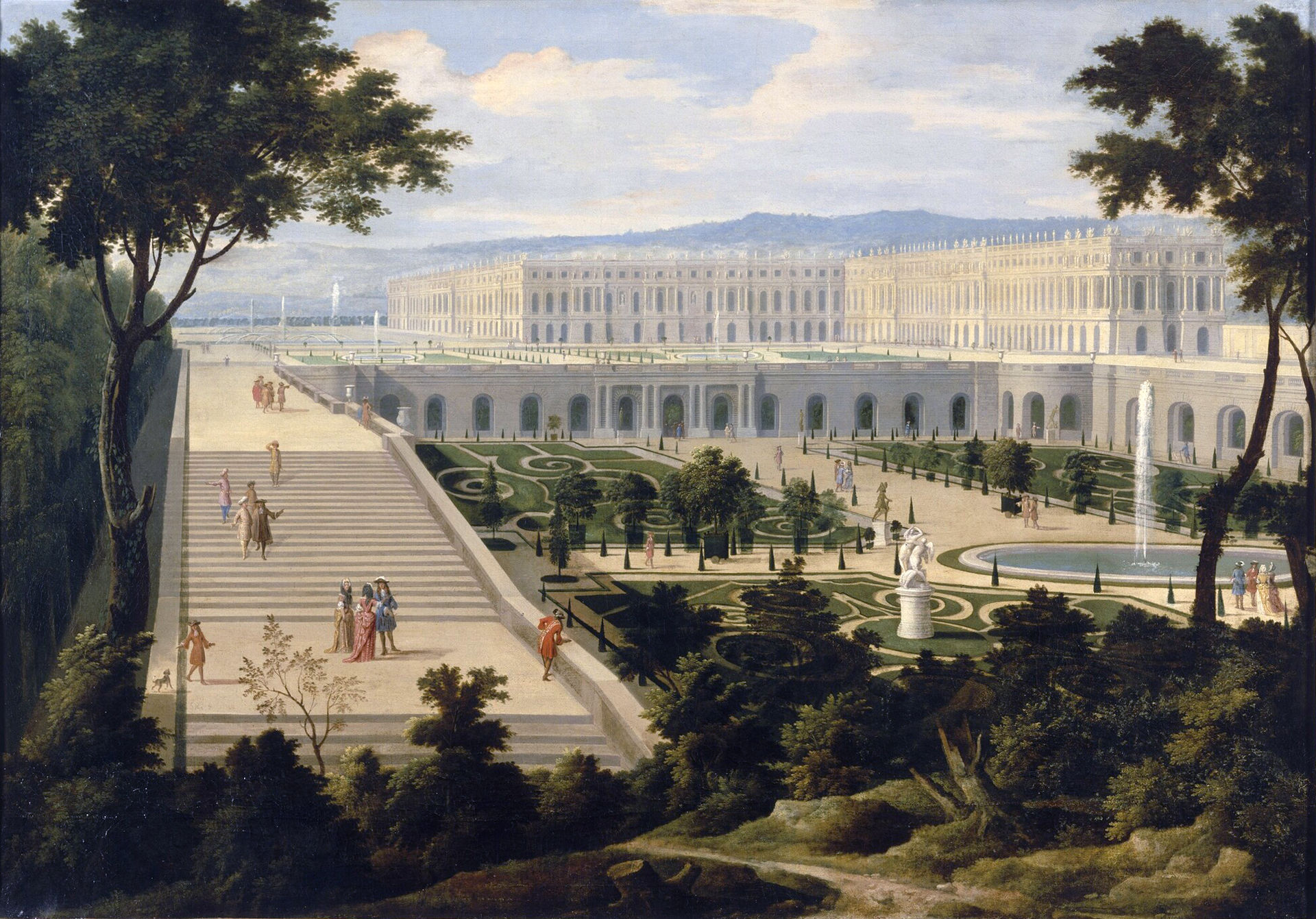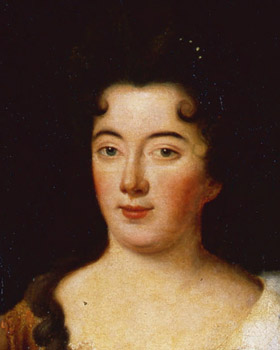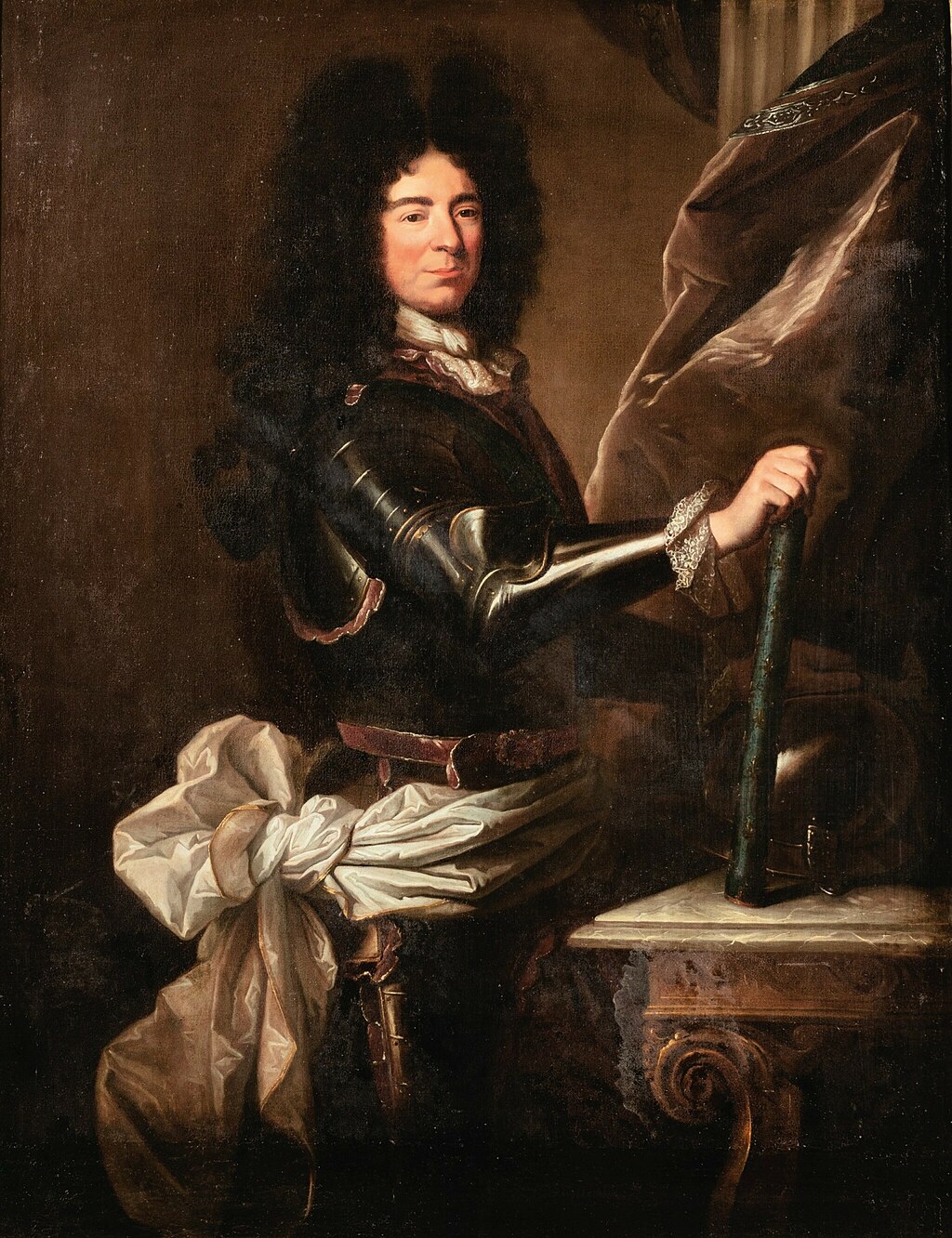Marie Thérèse was brought to France in 1660 as the bride of Louis XIV. Her marriage had a dual purpose: ending hostilities between France and Spain and producing an heir to the French throne. Marie Thérèse duly fell pregnant the following year and would eventually give birth to a total of six children - and bury five. As queen of France, she was subjected to the ritual of public childbirth; unfortunately, two of her pregnancies proved to be near-fatal to the mother.
From the moment Marie Thérèse had fallen pregnant, she had taken precautions. Not only would a miscarriage obviously involve a set-back in the plans for filling the nursery but Marie Thérèse had her own reasons for being apprehensive. Her own mother had died from complications of a miscarriage and Marie Thérèse was understandably afraid of suffering the same fate. Consequently, she remained firmly planted in sofas for as long as possible.
 |
| Marie Thérèse as a young woman |
The birth of the Grand Dauphin
On 31 October 1661, the court was informed that the queen had gone into labour. Marie Thérèse had become queen of France the year before when she married her first-cousin, Louis XIV. The new queen quickly became pregnant and by Halloween, the baby was due.
Marie Thérèse was facing an arduous deal. By tradition, the birth of an heir to the throne was not a private event and her bedchamber was filled with those high enough on the hierarchical ladder to bear witness to the event. This precaution was to ensure that a stillborn, disabled or - gasp - female child was not substituted for a healthy, male child. While those who were present would eventually see the birth of the Grand Dauphin, they would also witness a harrowing birth.
The young queen - 23 years old - was experiencing her first childbirth. According to contemporary sources, the birth was particularly difficult. The labour dragged on and on throughout the night, thus utterly exhausting Marie Thérèse. Louis XIV remained by her side until five in the morning when he was informed that the queen might not survive the childbirth. He then removed himself to the chapel and prayed for his wife - and son. Having prayed for a while, the king returned to the queen, took her hand and remained by her side until the child was finally born.
For hours, it was uncertain whether Marie Thérèse would survive the birth. The situation became so dire that she was administered the last rites. As it happens, a royal birth was always attended by various high-ranking clergymen for this particular situation. One of those present was the Abbé de Choisy - he would later be present at the birth of the Grand Dauphin's own first child.
Another witness was Marguerite de La Cuisse. She had neither high rank nor great fortune - but she was a "wise woman" or as close to a midwife as possible. Naturally, the queen was already surrounded by doctors but the presence of a woman whose sole profession was to deliver children must have been a comfort to Marie Thérèse. Marguerite lived and worked in Paris and the king is said to have issued a secret order to fetch her for the birth. There appears to have been a collaboration between Marguerite and the doctors - somewhat unusual for the time, but it serves to show the respect Marguerite had earned in her trade.
It was mentioned that the queen was already ill when she went into labour which could hardly have been beneficial to the strength she needed for the ordeal ahead.
The poor Marie Thérèse was finally released from her agony just before noon on 1 November, when her son was born. Undoubtedly, the experience must have been terrible for her - the pain and anxiety in itself but also having to go through that in front of a group of spectators. Over the next decade, she would repeat the process a further five times - and buried all five successive children.
While the king's behaviour was both supportive and kind, his attention did not remain long with his long-suffering wife. Having completed a thanksgiving pilgrimage to Chartres, he returned directly to court - but not to the queen. Instead, he rejoined his mistress, Louise de La Valliere, while Marie Thérèse was left to recover by herself and her ladies. The king and queen's relationship was said to have rewarmed after the birth but the position of Louise de La Valliere as the king's official mistress was undeniable - and likely hard for the queen to ignore. In fact, she was said to be heart-broken by the increasingly obvious affair.
 |
| Marie Thérèse with the Grand Dauphin |
A second close call
In the first half of 1664, it became obvious that the queen was pregnant again. Her last child had been born in November 1662 (a son who died that same December) and hopes were high that the queen would deliver a third son. For months, the pregnancy progressed as planned. Marie Thérèse was scheduled to give birth in December 1664 - but then something went wrong.
In early November, the queen's health went drastically downhill. She became feverish and complained of pains in her legs and back. While it may be expected that a woman in her eight month of pregnancy would experience unpleasant sensations in both legs and back, the queen's situation was far worse than just unpleasantness. In fact, she was said to be in considerable pain.
On 16 November - nearly a month before her due date - Marie Thérèse went into labour in dramatic fashion. Once again, Marie Thérèse nearly succumbed during the birth. As she gave birth, Marie Thérèse became so weak that the clergymen brought out the last sacraments again. However, this time Marie Thérèse utterly refused to take them. She is said to have uttered: "I will gladly take communion but I do not want to die".
As before, Louis XIV was by her side and it was he who eventually convinced her to submit to the last rites. The fact that she eventually gave in undoubtedly gives the impression that Marie Thérèse herself felt her strength waning. The birth dragged on and on to the point where Louis XIV allegedly inquired whether it would be possible to save the mother before the child was born.
The doctors present were utterly helpless and their solution was more cruel than helpful. Their remedy was to force-feed the poor Marie Thérèse an emetic intended to make her vomit. Initially, Marie Thérèse understandably refused - can anyone blame her? - but the doctors wore her down. Once the emetic had taken its toll, Marie Thérèse was utterly exhausted. Seemingly by miracle, the child was eventually born - a girl who was promptly named Marie-Anne. The infant had been severely deprived of oxygen and was born almost purple in the face (this would later give rise to the unsubstantiated rumour that the queen had had a black child).
The doctors managed to revive the young Marie-Anne while Marie Thérèse herself was barely hanging on to life. In fact, afterwards, she suffered from severe convulsions which further weakened her health. It was suspected that she suffered "an attack of the nerves" for which her attendants threw water in her face. The conclusion was that she had generally nervous disposition and had become over-agitated by the ordeal - it is hard to see how anyone, stoic or hysterical by nature, could remain level-headed after such a terrible experience.
Sadly, Marie-Anne lived for just a little more than month, dying on 26 December 1664.
... and a third
Two years passed before Marie Thérèse found herself pregnant again - one could hardly blame her if she was apprehensive. On the very first day of 1667, Marie Thérèse went into labour for the fourth time after having gone through an entire nine months pregnancy.
As usual, the traditional birthing process was put into place. Louis XIV duly found his way into her chamber where he allegedly helped the leading doctor, Félix, strap Marie Thérèse's legs down to the birthing bed. Whether she had been restrained in a similar fashion previously is unclear but it can hardly have been reassuring.
The birth - like the previous ones - was a long one. It was not until the following day (2 January 1667) that the child was born: another daughter, named Marie Thérèse after her long-suffering mother. She would become known as Petite Madame and for years, she seemed to thrive. Tragically, she died of consumption at age 5.
While Marie Thérèse recovered, court life went on. Just fifteen hours after the labour had ended, the court enjoyed the spectacle of a ballet composed by Molière, in which the king himself danced - alongside his mistress, Louise de La Vallière.
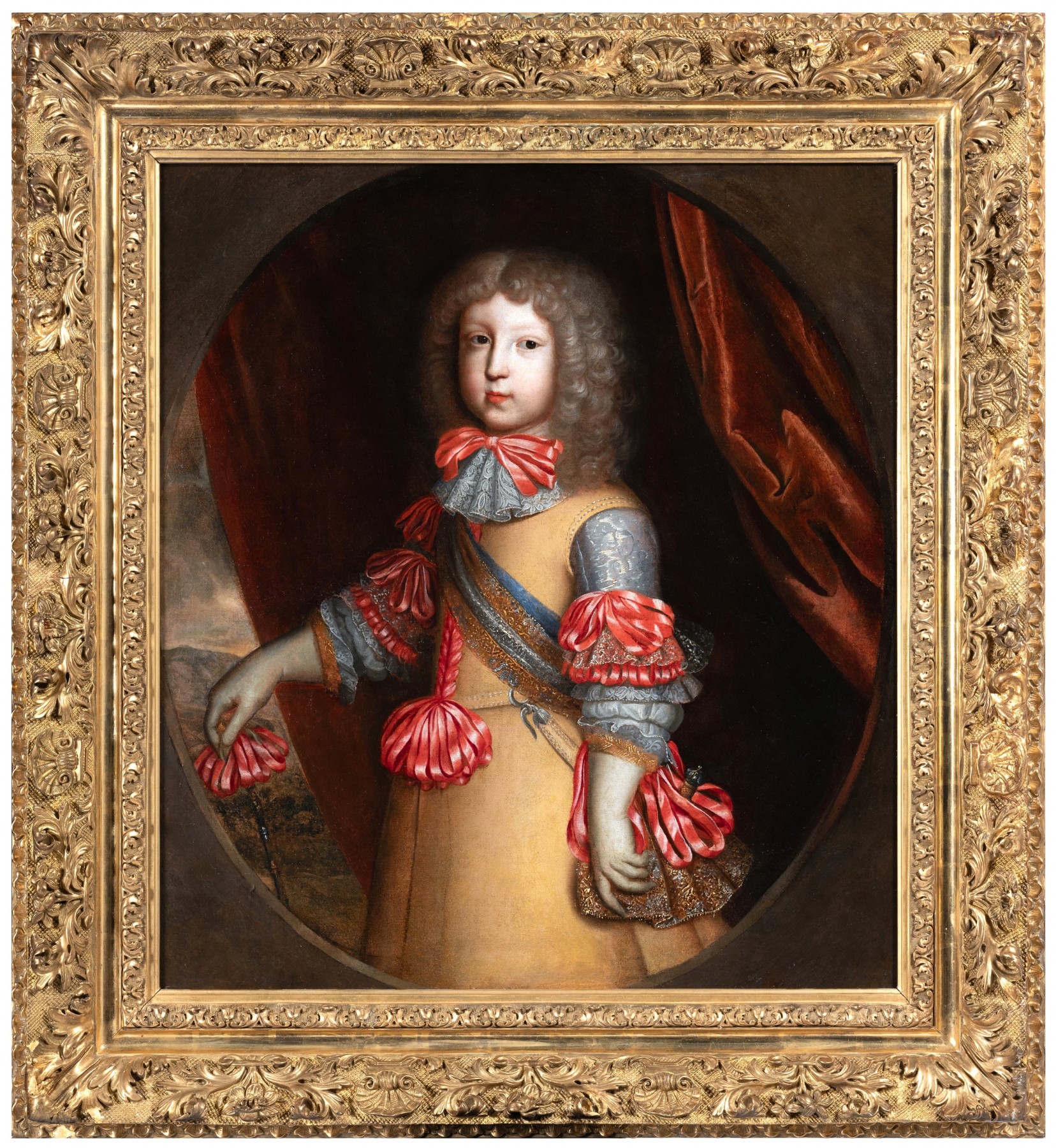 |
The Grand Dauphin - only surviving child
of Marie Thérèse |
The three episodes were tragically typical of the treatment of Marie Thérèse - and other royal women. Nothing was mentioned about whether she received any care after her ordeal - such a thing would simply not have been recorded. In fact, that the birth of the dauphin was so difficult in itself is hardly ever mentioned at all. Instead, biographies of the king or the court typically only mention that the queen gave birth but never bothers to elaborate on the sufferings she went through or the fact that she nearly died. Ironically, the celebrations that followed the birth has been given more attention than the process which occasioned them.
Likewise, the attentions bestowed upon her by the king was the focus point of considerable admiration. Naturally, this was a time when kings - or fathers in general - were rarely (if ever) involved in childbirth which did make the king's contribution both touching and unusual. However, the comment made by Madame de Motteville during the birth of the Grand Dauphin is quite telling:
"As long as she (the queen) was in great pain, the king seemed so distressed and so noticeably overcome with pain that he left no doubt of the love he had for her"
Full of admiration and attention of the king - the near-dying queen reduced to being in "great pain" while her husband is praised to the skies. Even afterwards, the efforts of the queen was not touched upon again.
Even for the standards of the time, the childbirths experienced by Marie Thérèse seems overly brutal. Strapped down, force-fed emetics and having religious items shoved in her face - icons of her own imminent death - there was nothing glamorous about Marie Thérèse's experiences. The queen herself left no trace of her own feelings in writing nor do any of the numerous memoirs seem to have given it a second thought.
Was she apprehensive upon her next pregnancy? She could hardly not have been anything but nervous, especially given her preexisting fears. Did she receive any post-natal care? How did she feel herself, how did she experience the ordeals? We do not know.

